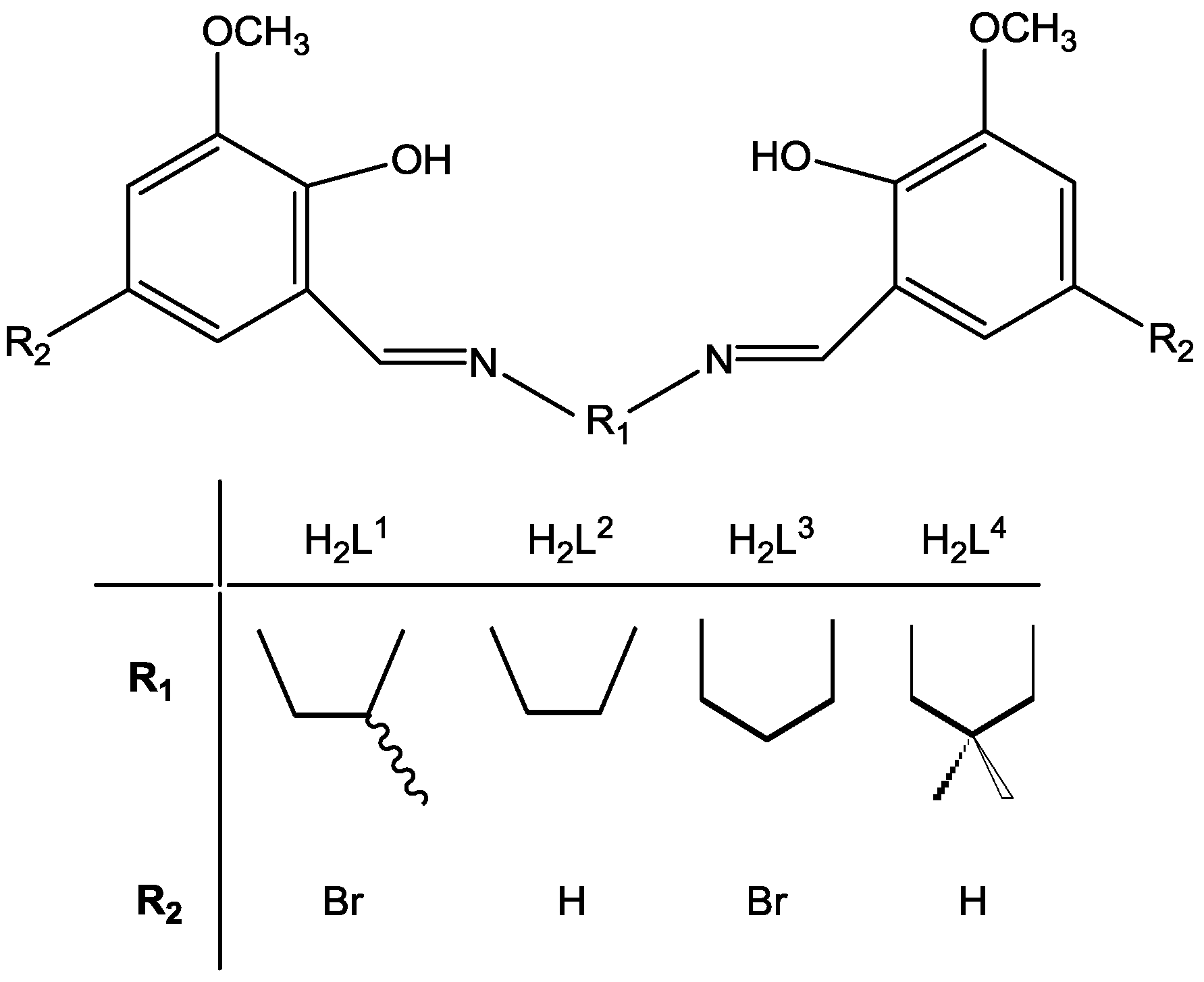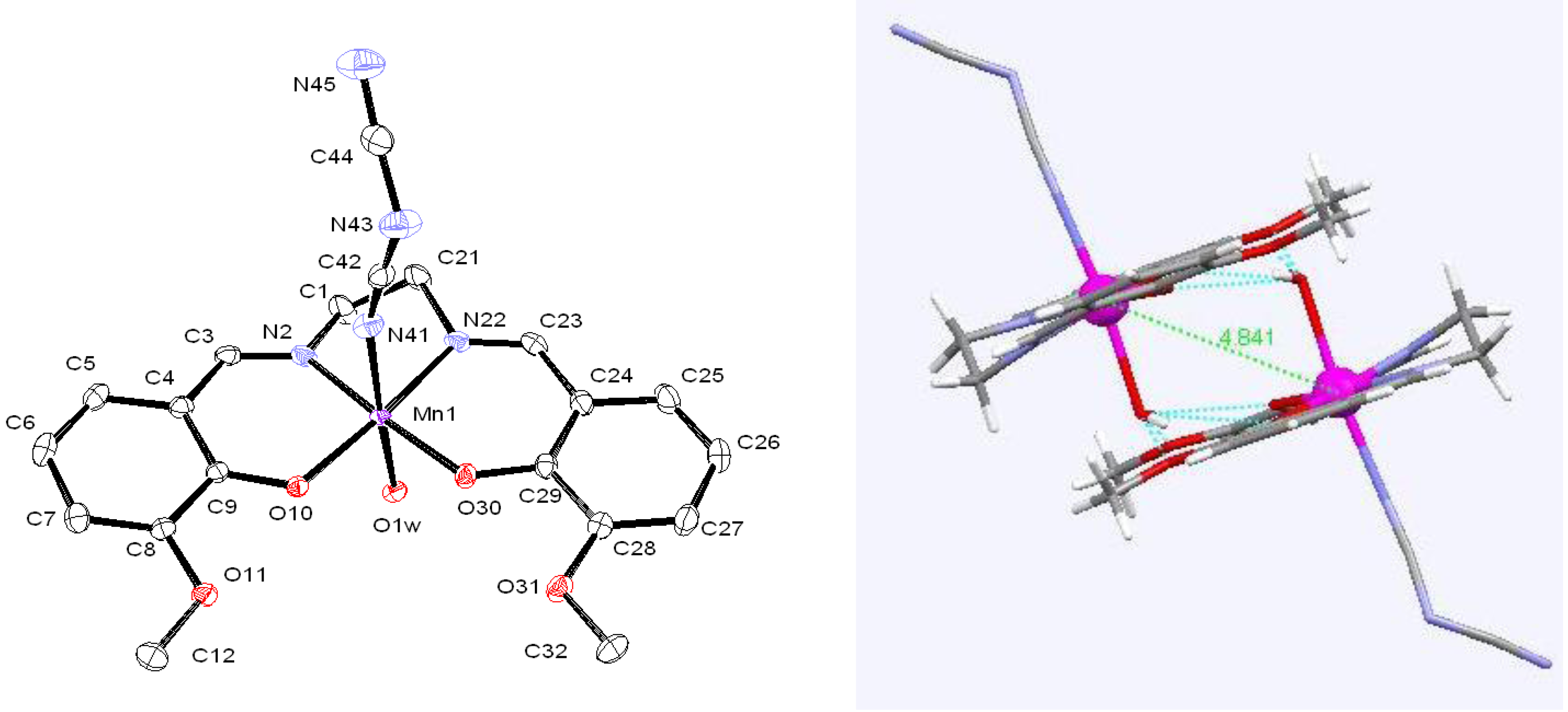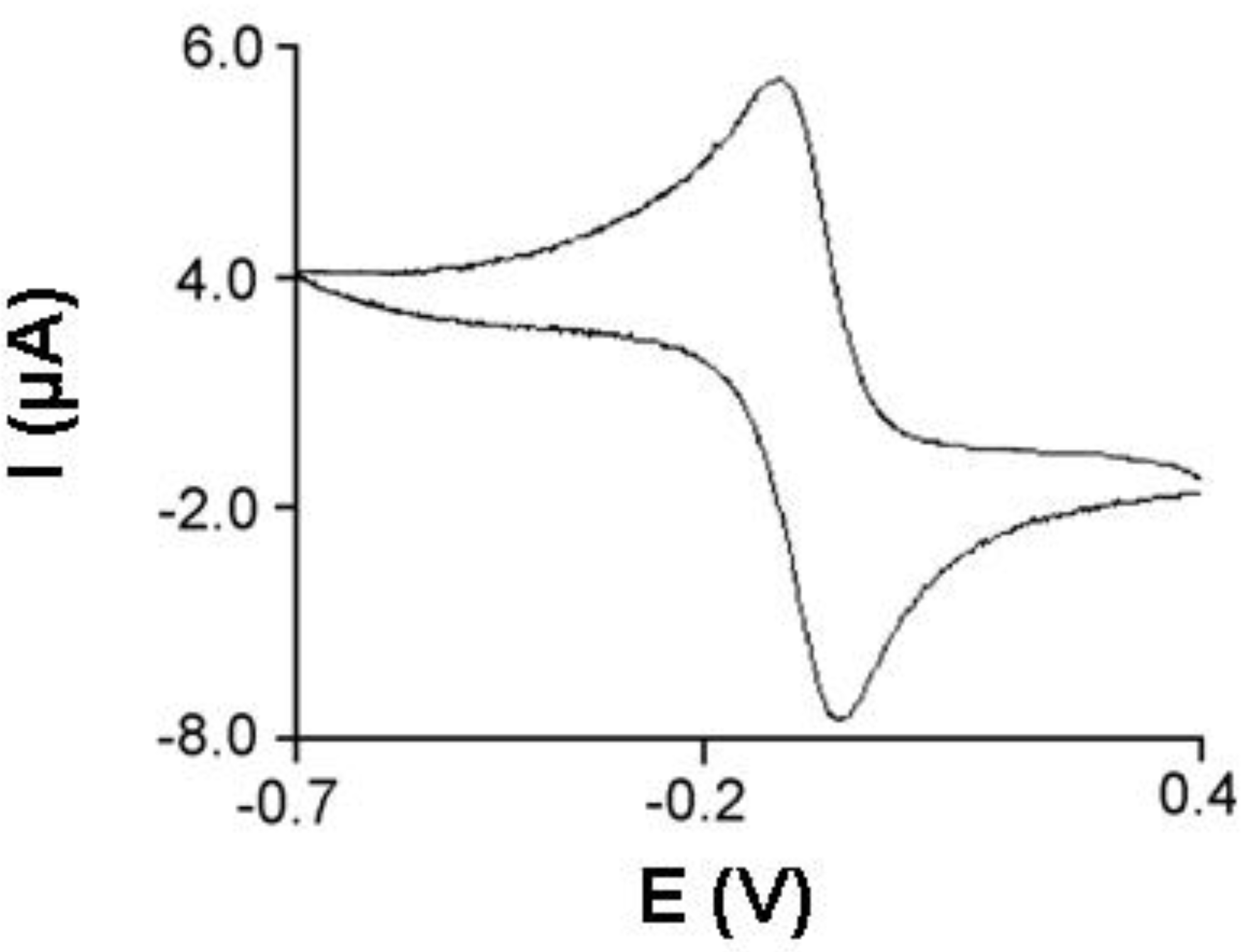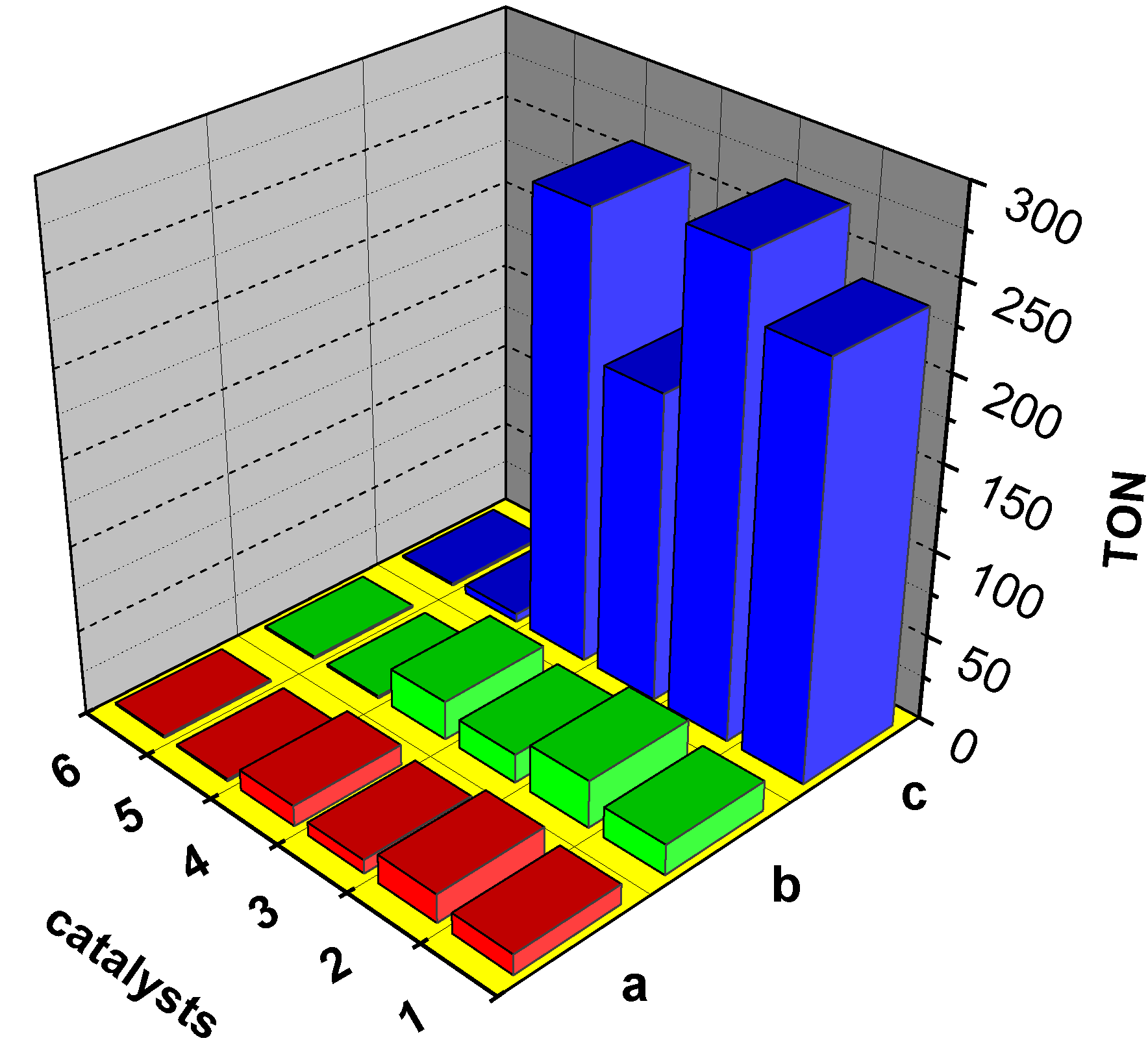Biomimetic Catalysts for Oxidation of Veratryl Alcohol, a Lignin Model Compound
Abstract
:1. Introduction

2. Results and Discussion
2.1. Synthesis and Characterization of the Complexes
- The broad unsplit band at 1120 cm−1 in 1 and 5 is indicative of the presence of the uncoordinated perchlorate anion [12], its characteristic ν4 stretching mode at ca. 635 cm−1 can also easily be identified;
- Two new bands at 1546 and 1438 cm−1 in 2 are assigned to the symmetric and asymmetric acetylacetonate bidentate modes suggesting its coordination to the manganese ion [17];
- The appearance of a new strong and sharp band at 1384 cm−1, together with bands at ca. 740 and 850 cm−1 are characteristic of the non-coordinated nitrate counterion in complexes 3 and 6 [18];
- Two new bands at 2148 and 2266 cm−1 in 4 are assigned to the symmetric and asymmetric diacyanamide modes [19].
2.2. Crystal Structure of 4

| Mn1-O10 | 1.885(15) | Mn1-O30 | 1.881(15) |
|---|---|---|---|
| Mn1-N2 | 1.981(18) | Mn1-N22 | 1.990(19) |
| Mn1-N41 | 2.255(2) | Mn1-O1w | 2.303(16) |
| O10-Mn1-O30 | 93.78(6) | N2-Mn1-N22 | 82.52(8) |
| N41-Mn1-O1w | 174.32(7) | O10-Mn1-N41 | 94.00(7) |
| O10-Mn1-O1w | 90.66(7) | O30-Mn1-O1w | 90.11(6) |
2.3. Electrochemical Studies

| Eox | Ered | E1/2 | ∆ E(ox-red) | |
|---|---|---|---|---|
| 1 | −0.034 | −0.114 | −0.074 | 0.080 |
| 3 | −0.154 | −0.237 | −0.196 | 0.083 |
| 4 | 0.047 | −0.057 | −0.005 | 0.104 |
| 5 | 0.068 | −0.040 | 0.014 | 0.108 |
2.4. Peroxidase Studies


2.5. Oxidation of the Lignin Analogue Veratryl Alcohol

3. Experimental Section
3.1. Materials
3.2. Physical Measurements
3.3. Synthesis of the Complexes
3.4. X-ray Diffraction Studies
| Empirical formula | C20H20MnN5O5 |
|---|---|
| Formula weight | 465.35 |
| Temperature [K] | 100(2) |
| Wavelength [Å] | 0.71073 |
| Crystal system | Monoclinic |
| Space group | P21/c |
| a [Å] | 11.3350(4) |
| b [Å] | 21.7336(9) |
| c [Å] | 8.5965(3) |
| α [°] | 90 |
| β [°] | 108.591(2) |
| γ [°] | 90 |
| Volume [Å3] | 2007.24(13) |
| Z | 4 |
| Dcalcd. [g cm−3] | 1.540 |
| μ [mm−1] | 0.702 |
| F(000) | 960 |
| θmin/max[°] | 1.87/27.88 |
| Total data | 28313 |
| Unique data | 4792 |
| Final R indices [I > 2σ(I)] | R1 = 0.0417; wR2 = 0.1109 |
| R indices (all data) | R1 = 0.0494; wR2 =0.1163 |
3.5. Peroxidase Probes
3.6. Oxidation of Veratryl Alcohol
4. Conclusions
Acknowledgments
Conflict of Interest
References
- Sixta, H.; Potthast, A.; Krotschek, A.W. Chemical pulping processes. In Handbook of Pulp; Sixta, H., Ed.; Wiley-VCH: Winheim, Germany, 2006. [Google Scholar]
- Isroi, I.; Millati, R.; Syamsiah, S.; Niklasson, C.; Cahyanto, M.N.; Lundquist, K.; Taherezadeh, M.J. Biological pretreatment of lignocelluloses with white-rot fungi and its applications: a review. Bioresources 2011, 6, 5224–5259. [Google Scholar]
- Pokhrel, D.; Viraraghavan, T. Treatment of pulp and paper mill wastewater –a review. Sci. Total Environ. 2004, 333, 37–58. [Google Scholar] [CrossRef]
- Muñoz, I.; Rieradevall, J.; Torrades, F.; Peral, J.; Domènech, X. Environmental assessment of different advanced oxidation processes applied to a bleaching Kraft mill effluent. Chemosphere 2006, 62, 9–16. [Google Scholar] [CrossRef]
- Bajpai, P. Biological bleaching of chemical pulps. Crit. Rev. Biotechnol. 2004, 24, 1–58. [Google Scholar] [CrossRef]
- Galliano, H.; Gas, G.; Seris, J.L.; Boudet, A.M. Lignin degradation by rigidoporus-lignosus involves synergistic action of 2-oxidizing enzymes- Mn peroxidase and laccase. Enzyme Microb. Technol. 1991, 13, 478–482. [Google Scholar] [CrossRef]
- Hage, R.; Lienke, A. Applications of transition-metal catalysts to textile and wood-pulp bleaching. Angew. Chem. Int. Ed. 2006, 45, 206–222. [Google Scholar] [CrossRef]
- Chen, C.-L.; Capanema, E.A.; Gracz, H.S. Reaction mechanisms in delignification of pine Kraft-AQ pulp with hydrogen peroxide using Mn(IV)-Me4DTNE as catalyst. J. Agric. Food Chem. 2003, 51, 1932–1941. [Google Scholar] [CrossRef]
- Biava, H.; Signorella, S. Peroxidase activity of dimanganese(III) complexes with the [Mn2(µ-OAc)(µ-OR)2]3+ core. Polyhedron 2010, 29, 1001–1006. [Google Scholar] [CrossRef]
- Dolphin, D.; Traylor, T.G.; Xie, L.Y. Polyhaloporphyrins: Unusual ligands for metals and metal-catalyzed oxidations. Acc. Chem. Res. 1997, 30, 251–259. [Google Scholar] [CrossRef]
- Crestini, C.; Pastorini, A.; Tagliatesta, P. Metalloporphyrins immobilized on motmorillonite as biomimetic catalysts in the oxidation of lignin model compounds. J. Mol. Catal. A 2004, 208, 195–202. [Google Scholar] [CrossRef]
- Bermejo, M.R.; Fernández, M.I.; Gómez-Fórneas, E.; González-Noya, A.; Maneiro, M.; Pedrido, R.; Rodríguez, M.J. Self-assembly of dimeric Mn(III)-Schiff-base complexes tuned by perchlorate anions. Eur. J. Inorg. Chem. 2007, 2007, 3789–3797. [Google Scholar]
- Vázquez-Fernández, M.A.; Bermejo, M.R.; Fernández-García, M.I.; González-Riopedre, G.; Rodríguez-Doutón, M.J.; Maneiro, M. Influence of the geometry around the manganese ion on the peroxidase and catalase activities of Mn(III)-Schiff base complexes. J. Inorg. Biochem. 2011, 105, 1538–1547. [Google Scholar] [CrossRef]
- Maneiro, M.; Bermejo, M.R.; Fernández, M.I.; Gómez-Fórneas, E.; González-Noya, A.M.; Tyryshkin, A.M. A new type of manganese-Schiff base complex, catalysts for the disproportionation of hydrogen peroxide as peroxidase mimics. New J. Chem. 2003, 27, 727–733. [Google Scholar]
- Bermejo, M.R.; Fernández, M.I.; González-Noya, A.M.; Maneiro, M.; Pedrido, R.; Rodríguez, M.J.; García-Monteagudo, J.C.; Donnadieu, D. Novel peroxidase mimics: µ-Aqua manganese-Schiff base dimers. J. Inorg. Biochem. 2006, 100, 1470–1478. [Google Scholar] [CrossRef]
- Zucca, P.; Sollai, F.; Garau, A.; Rescigno, A.; Sanjust, E. Fe(III)-5,10,15,20-tetrakis(pentafluorophenyl)porphine supported on pyridyl-functionalized, crossliked poly(vinyl alcohol) as biomimetic versatile-peroxidase-like catalyst. J. Mol. Catal. A 2009, 306, 89–96. [Google Scholar] [CrossRef]
- Bermejo, M.R.; Fondo, M.; Garcia-Deibe, A.; González-Noya, A.M.; Sousa, A.; Sanmartín, J.; McAuliffe, C.A.; Pritchard, R.G.; Watkinson, M.; Lukov, V. Studies of the binding modes of carboxylate donors with manganese(III) complexes containing tetradentate Schiff base ligands. Crystal structures of the complexes [Mn(3-CH3Osalpn)(HO2CC6H4CO2)]n and [{Mn(5-NO2salpn)(OH)(H2O)} [{Mn(5-NO2salpn)(HO2CC6H4CO2)(H2O)}·C2H5OH. Inorg. Chim. Acta 1999, 293, 210–217. [Google Scholar] [CrossRef]
- Kong, D.; Xie, Y. Synthesis, structural characterization of tetraazamacrocyclic ligand, five-coordinated zinc(II). Inorg. Chim. Acta 2002, 338, 142–148. [Google Scholar] [CrossRef]
- Majumder, A.; Pilet, G.; Garland, M.T.; Mitra, S. Synthesis and structural characterisation of three dicyanamide complexes with Mn(II), Zn(II) and Cd(II): Supramolecular architectures stabilised by hydrogen bonding. Polyhedron 2006, 25, 2550–2558. [Google Scholar] [CrossRef]
- Constable, E.C.; Housecroft, C.E.; Kopecky, P.; Schonhofer, E.; Zampese, J.A. Restricting the geometrical relaxation in four-coordinate copper(I) complexes using face-to-face and edge-to-face π-interactions. CrystEngComm 2011, 13, 2742–2752. [Google Scholar] [CrossRef]
- Eulering, B.; Schmidt, M.; Pinkernell, V.; Karst, U.; Krebs, B. An unsymmetrical dinuclear iron(III) complex with peroxidase properties. Angew. Chem. Int. Ed. 1996, 35, 1973–1974. (in English). [Google Scholar] [CrossRef]
- Cozzi, P.G. Metal-Salen Schiff base complexes in catalysis: practical aspects. Chem. Soc. Rev. 2004, 33, 410–421. [Google Scholar] [CrossRef]
- Hage, R.; Lienke, A. Bleach and oxidation catalysis by manganese-1,4,7-triazacyclononane complexes and hydrogen peroxide. J. Mol. Catal. A 2006, 251, 150–158. [Google Scholar] [CrossRef]
- Signorella, S.; Hureau, C. Bioinspired functional mimics of the manganese catalases. Coord. Chem. Rev. 2012, 256, 1229–1245. [Google Scholar] [CrossRef]
- Oliveri, V.; Puglisi, A.; Vecchio, G. New conjugates of β-cyclodextrin with manganese(III) salophen and porphyrin complexes as antioxidant systems. Dalton Trans. 2011, 40, 2913–2919. [Google Scholar] [CrossRef]
- González-Riopedre, G.; Fernández-García, M.I.; González-Noya, A.M.; Vázquez-Fernández, M.; Bermejo, M.R.; Maneiro, M. Manganese-Schiff base complexes as catalysts for water photolysis. Phys. Chem. Chem. Phys. 2011, 13, 18069–18077. [Google Scholar]
- Kervinen, K.; Lahtinen, P.; Repo, T.; Svanh, M.; Leskela, M. The effect of reaction conditions on the oxidation of veratryl alcohol catalyzed by cobalt salen-complexes. Catal. Today 2002, 75, 183–188. [Google Scholar]
- Liu, A.; Huang, X.; Song, S.; Wang, D.; Xuemei, L.; Qu, Y.; Gao, P. Kinetics of the H2O2-dependent ligninase-catalyzed oxidation of veratryl alcohol in the presence of cationic surfactant studied by spectrophotometric technique. Spectrochim. Acta Part A 2003, 59, 2547–2551. [Google Scholar] [CrossRef]
- Simandi, L. Advances in Catalytic Activation of Dioxygen by Metal Complexes; Kluwer Academic Publishers: Dordrecht, The Netherlands, 2003. [Google Scholar]
- Korpi, H.; Sippola, V.; Filpponen, I.; Sipilä, J.; Krausse, O.; Leskeläm, M.; Repo, R. Copper-2,2'-bipyridines: Catalytic performance and structures in aqueous alkaline solutions. Appl. Catal. A 2006, 302, 250–256. [Google Scholar] [CrossRef]
- Zakzeski, J.; Jongerius, A.L.; Weckhuysen, B.M. Transition metal catalyzed oxidation of Alcell lignin, soda lignin, and lignin model compounds in ionic liquids. Green Chem. 2010, 12, 1225–1236. [Google Scholar] [CrossRef]
- Crestini, C.; Pastorini, A.; Tagliatesta, P. The immobilized porphyrin-mediaton system Mn(TMePyP)/clay/HBT (clay-PMS): A Lignin peroxidase biomimetic catalyst in the oxidation of lignin and lignin model compounds. Eur. J. Inorg. Chem. 2004, 4477–4483. [Google Scholar]
- Cui, F.; Dolphin, D. Iron porphyrin catalyzed oxidation of lignin model compounds: the oxidation of veratryl alcohol and veratryl acetate. Can. J. Chem. 1992, 70, 2314–2318. [Google Scholar] [CrossRef]
- Sippola, V.O.; Krause, A.O.I. Bis(O-phenanthroline)copper-catalysed oxidation of lignin model compounds for oxygen bleaching of pulp. Catal. Today 2005, 100, 237–242. [Google Scholar] [CrossRef]
- Sheldrick, G.M. SHELX-97 (shelxs 97 and shelxl 97), Programs for Crystal Structure Analyses, version 97-1; University of Göttingen: Göttingen, Germany, 1997. [Google Scholar]
- Sheldrick, G.M. SADABS (Program for Scaling and Correction of Area Detector Data), version 2008/1; University of Göttingen: Göttingen, Germany, 2008. [Google Scholar]
© 2013 by the authors; licensee MDPI, Basel, Switzerland. This article is an open access article distributed under the terms and conditions of the Creative Commons Attribution license (http://creativecommons.org/licenses/by/3.0/).
Share and Cite
González-Riopedre, G.; Fernández-García, M.I.; Gómez-Fórneas, E.; Maneiro, M. Biomimetic Catalysts for Oxidation of Veratryl Alcohol, a Lignin Model Compound. Catalysts 2013, 3, 232-246. https://doi.org/10.3390/catal3010232
González-Riopedre G, Fernández-García MI, Gómez-Fórneas E, Maneiro M. Biomimetic Catalysts for Oxidation of Veratryl Alcohol, a Lignin Model Compound. Catalysts. 2013; 3(1):232-246. https://doi.org/10.3390/catal3010232
Chicago/Turabian StyleGonzález-Riopedre, Gustavo, María Isabel Fernández-García, Esther Gómez-Fórneas, and Marcelino Maneiro. 2013. "Biomimetic Catalysts for Oxidation of Veratryl Alcohol, a Lignin Model Compound" Catalysts 3, no. 1: 232-246. https://doi.org/10.3390/catal3010232






